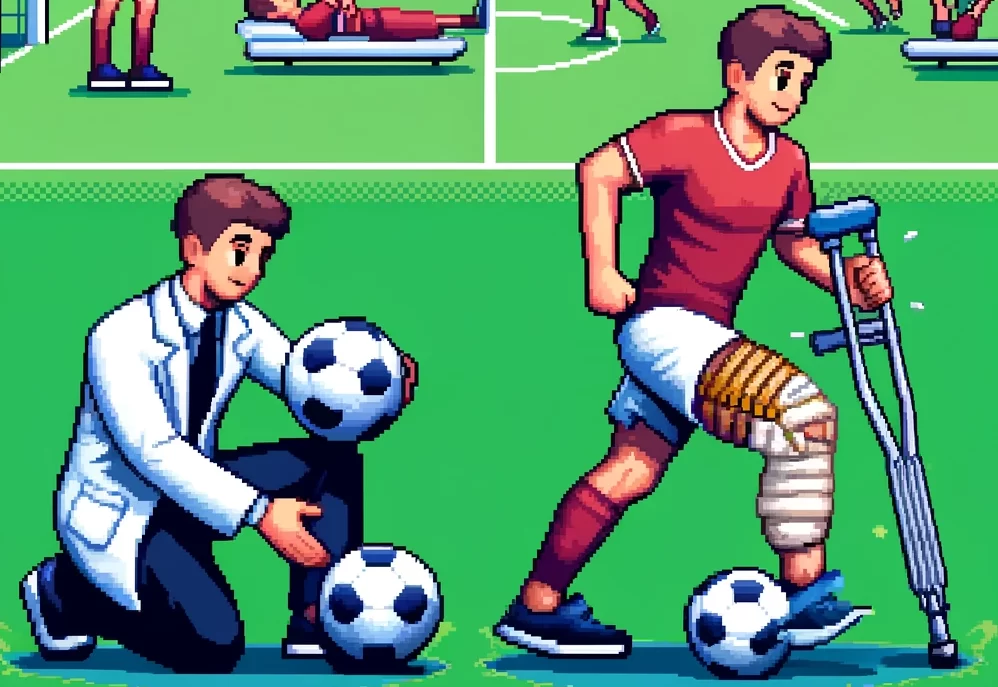
Recovery after ACL Reconstruction
In the world of soccer, where the thrill of a goal and the agony of defeat are part of the game, another drama unfolds quietly yet profoundly: the battle against injuries. Among these, the anterior cruciate ligament (ACL) rupture stands out. It’s not just a medical term but a pivotal event that can reshape a player’s career. Understanding the implications of ACL injuries and the road to recovery can provide valuable insights for coaches, players, and enthusiasts alike.
The Growing Challenge of ACL Injuries
Soccer’s popularity has surged globally, with millions of players striving for excellence. This increased participation, however, comes with a rise in injuries, particularly to the knee and ankle joints and the muscles of the thigh and calf. ACL ruptures are especially concerning due to their impact on knee stability and movement.
Research highlights that ACL injuries are prevalent among soccer players, affecting their quality of life and imposing significant financial burdens on society. Female players and older athletes face higher risks, and the frequency of these injuries is notable across different levels of competition. For instance, studies indicate that elite Italian soccer athletes have an incidence rate of 0.4215 per 1000 hours of play.
Returning to the Field
The journey back to the soccer field after an ACL rupture often involves ACL reconstruction (ACLR). The success rate of returning to play (RTP) post-surgery is quite promising. A systematic review showed that 82% of athletes successfully returned to play after ACLR. However, the fear of reinjury remains a significant barrier, causing many players to reduce their participation or quit the sport altogether.
On average, players take about 6 to 13 months to recover and return to competitive play. Yet, the path to recovery is fraught with psychological and physical challenges. The fear of another injury and knee-related issues are the most common reasons for not returning to the sport.
Performance Post-Recovery
The question of whether players can regain their pre-injury form is crucial. Performance metrics after ACLR present a mixed picture. Some studies report significant declines in performance, while others find no substantial differences. For example, NFL players showed a decrease in games started and tackles post-ACLR, while no such decline was observed in hockey players.
In soccer, the picture is similarly complex. While many players return to play, only about 53% can compete at their pre-injury level. Moreover, the recovery time for elite players tends to be shorter compared to amateur or recreational athletes. Despite returning to the field, many athletes face a reduced career length, averaging between 4 and 5 years post-surgery.
The Road Ahead for Coaches and Players
Prevention and effective rehabilitation programs are essential to mitigate the impact of ACL injuries. Coaches should work closely with physiotherapists and sports psychologists to address both the physical and mental aspects of recovery.
Innovative training techniques that enhance knee stability and strength can play a pivotal role in reducing injury risks. Furthermore, creating an environment that supports mental resilience can help players overcome the fear of reinjury.
Practical Tips for Coaches and Players
- Prevention Strategies: Implement training programs focusing on knee stability, strength, and agility. Exercises like plyometrics, balance training, and strength conditioning can be highly effective.
- Rehabilitation Programs: Collaborate with medical professionals to design comprehensive rehab programs that address both physical recovery and psychological readiness.
- Mental Health Support: Encourage open discussions about the fear of reinjury. Sports psychologists can provide valuable support in building confidence and mental resilience.
- Monitoring and Feedback: Use technology to track recovery progress and performance metrics. Regular feedback can help adjust training programs and prevent overtraining.
Engagement and Community Support
Encouraging discussions and sharing experiences can build a supportive community around players recovering from ACL injuries. Here are a couple of questions to spark conversation in the comments!
- For Players: What has been the most challenging aspect of your recovery from an ACL injury, and how did you overcome it?
- For Coaches: What innovative training techniques have you implemented to prevent ACL injuries, and what results have you observed?
By sharing insights and experiences, we can create a knowledge base that benefits players, coaches, and the soccer community as a whole.
Conclusion
ACL injuries in soccer present significant challenges but also opportunities for growth and innovation in training and rehabilitation. By understanding the journey of recovery and the factors influencing RTP and performance, coaches and players can better navigate the road to recovery. Collaborative efforts in prevention, rehabilitation, and mental health support can make a significant difference, ensuring that players not only return to the field but also excel in their careers.
Step into the forefront of soccer innovation with ‘This Week in Soccer’.
Our newsletter is more than just words; it’s an interactive journey through the complexities of soccer analytics and strategy. Whether you’re a coach, educator, or enthusiast, our content is designed to spark curiosity and enhance your understanding. Subscribe today and be part of a community pushing the boundaries of soccer education.
About the Author
Jon Scaccia is a youth soccer coach and translational scientist. He has worked with the Exeter United Soccer Club for over five years, focusing on U5 development. In his day job, he works in data evaluation and implementation science.



